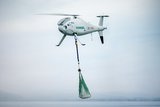Kongsberg Geospatial releases IRIS UxS 2.0
Kongsberg Geospatial has released IRIS UxS 2.0, an upgraded version of its IRIS UxS fleet control station and airspace management system, the company announced on 23 April.
IRIS UxS 2.0 is powered by the new Kongsberg Geospatial TerraLens 9.1 engine, providing faster 3D map and terrain performance on large 4K displays. The system has an entirely new user interface, and a wide range of new features, including support for new sensors; an integrated live national airspace data feed; and integrated autopilots – allowing operators to control UAS directly from the IRIS system.
IRIS UxS provides UAS operators with enhanced airspace awareness, navigational tools, and deconfliction and air safety features for beyond visual line of site (BVLOS) operators, while providing airspace managers with an integrated airspace picture that consolidates data from a wide range of real-time data feeds and sensors.
The fleet control station technology enables multiple UAS to be monitored and controlled simultaneously by a single operator and provides real-time calculation of aircraft separation, airspace monitoring alerts and communication line-of-sight prediction to enable detect and avoid for safe BVLOS operations. IRIS UxS integrates a variety of real-time data feeds including ADS-B, local radar and National Airspace Feeds to calculate detect and avoid warnings.
More from Uncrewed Vehicles
-
Jammer resistant drone designs spark search for countermeasures
The Russia-Ukraine conflict has driven another stage of evolution for drones and the counter measures to defend against them.
-
![L3Harris launches Amorphous software for control of uncrewed platforms]()
L3Harris launches Amorphous software for control of uncrewed platforms
The new Amorphous software is a universal controller that would allow a single operator to control a swarm of “thousands” of uncrewed systems, from drones to underwater platforms.
-
ideaForge unveils new UAVs at Aero India 2025
India UAV supplier ideaForge has launched the Netra 5 and Switch V2 drones at Aero India 2025, boasting of enhanced endurance, AI-driven autonomy and improved operational capabilities.
-
![Shaping the future of defence: What 2025 holds for the global drone market]()
Shaping the future of defence: What 2025 holds for the global drone market
The UAV market is experiencing unprecedented growth, with innovations in technology and battlefield applications driving demand across military sectors. From the battlefields of Ukraine to NATO exercises and beyond, drones are transforming how wars are fought and supported.
-
![Maris-Tech confirms customers signing up for Jupiter Drones codec and AI-powered system]()
Maris-Tech confirms customers signing up for Jupiter Drones codec and AI-powered system
Launched at AUSA in October, the company’s multi-stream video codec is attempting to bring a new lease of life to drone technology through its AI accelerator.
-
![AUSA 2024: Quantum-Systems targets big 2025 with UAS developments]()
AUSA 2024: Quantum-Systems targets big 2025 with UAS developments
Quantum-Systems has been upgrading its UAS family, with new versions of the Vector, Reliant and Twister drones set for release throughout 2025.
























